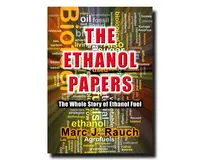Failed Ethanol Critic Takes Another Shot... But Misses Once Again
 |
The Problem for Colin A. Carter is that facts and the real world keep getting in the way
By Marc J. Rauch
Exec. Vice President/Co-Publisher
THE AUTO CHANNEL
 Marc J. Rauch |
Colin A. Carter is a professor of agricultural and resource economics at University of California, Davis. In October 2007, Mr. Carter delivered a Power Point presentation titled, "The Ethanol Boom." The presentation kicks off with three quotes about the ethanol business in America - one was favorable to ethanol, two were critical of ethanol.
One of the negative quotes (from Cato Institute) said, "If ethanol were an economically intelligent investment, you would not need to subsidize it from stem to stern."
The second negative quote (this from the Wall Street Journal) said, “Ethanol Industry is Losing Clout.”
 Colin A. Carter |
The Cato quote is a long standing generalized quote that detractors use when criticizing anything they don't like that benefits from some type of subsidy. I've had this battle before with Cato Institute. About ten years ago, I wrote to the top guy and said that "virtually everything of importance achieved in America required or benefited from a subsidy." He wrote back that "nothing of importance achieved in America required subsidy." I then reminded him of the opening of the west, the trans-continental railroad, hydro-electrical plants, the national highway system, nuclear energy plants, various communications media, the space program, and of course all the subsidies given to the oil industry. I never heard back from him.
As for the Wall St. Journal quote, history since 2007 has told a different story, although it has been tough to keep the oil wolves at bay.
Midway through the Power Point presentation, Mr. Carter offers some comparative production statistics and throws in the information that ethanol BTU content is 2/3 that of gasoline. This is an entirely extraneous
point since ethanol fuel is used to power internal combustion engines, not heat water for steam engines, but the ethanol boo-birds always think this factoid has some significance - not unlike the Cato subsidizing quote.
SEE ALSO: The Irrelevance Of BTU Rating - Big Oil's Gimmick To Hoodwink The Public
The presentation concludes with dual predictions that the "food vs fuel" debate will continue and that the "ethanol boom may be running out of gas." The "food-fuel" issue was always a canard (and may always be as long as the oil industry has any money in their propaganda war chest). And if the ethanol boom has run out of gas, it's only because there is no gas in ethanol...ethanol is in the gas! Ha ha ha. Bottom line, whatever Colin Carter intended with his 2007 presentation, it never materialized.
In July 2012, Mr. Carter combined with a molecular biologist named Henry I. Miller to write a New York Times editorial titled, "Corn for Food, Not Fuel."
I guess that Professor Colin figured he might as well try to wrangle some spare cash out of the Big Oil PR coffers, so he remembered this lame duck from his 2007 Power Point and found a doctor buddy to try and give the canard some feathers to fly (pun intended).
The stuffing they tried to use for the canard in 2012 was the exaggerated catastrophic consequences of that year's drought conditions (said to be the worst since 1956). Colin and Hank painted a very dire picture, citing everything from exorbitant food costs, to many farmers going bankrupt, to potentially starving livestock. Unfortunately for the dynamic duo, despite the drought, there was a corn surplus that year (again).
Moreover, the 2012 drought was predicted at that time to rollover to the next year and effect crop yield for 2013. As it turned out, the corn crop in 2013 was the highest on record (going back to just after the Civil War).
To me, the most humorous parts of the Carter/Miller 2012 NYT "warning" was the paragraph in which they blame the drought and questionable U.S. farming policies for sharply rising food prices and corn futures on the Chicago commodity market hitting record levels (rising 60%). But, of course, any rise in futures prices and food prices was not a result of a drought and farming policies, it was the result of commodity speculators pushing the prices up because of a panic that was caused (in no small fashion) by frivolous stories of catastrophe such as the Carter/Miller editorial.
A couple of years later, in February 2014, Mr. Carter was quoted in a Forbes magazine article as having spoken additional unwarranted, unsubstantiated, and ultimately unfulfilled admonishments facing the ethanol industry. Prof Colin did this by invoking the ominous blend wall (as fictional a horrific monster as there ever was), along with miscalculations of land resources and usage that would make Professors David Pimentel and Tad Patzek proud (Pimentel and Patzek were princes of preposterous petroleum-skewed proclamations - in other words, fony phacts).* All internal combustion engines can safely and economically use E15, regardless of age. This is proven by Brazil's decades long use of E15, E25, and now E27. They have the same engines as those available in the U.S. In addition, E15 to E30 was used throughout Great Britain from the 1920's to the 1970's. This is also true of other countries, including France and Germany.
There is no blend wall because there are no internal combustion engine vehicles that are truly restricted to E10 or less. A vehicle owner may wish to stick with the manufacturer's warranty policy in the
first years after purchase, but when the short warranty period is over (typically 3 years), the owner can do whatever he or she wants.
SEE ALSO: The Figurative Ethanol Blend Wall is a Fictional Ethanol Blend Wall
Then Carter suggests that the impact of renewable fuel policies could send gasoline prices soaring by 50 cents per gallon. This never happened. Gasoline and diesel prices do soar and spike, but it is always because of the manipulation of OPEC and/or the oil companies.
You'd think that Colin Carter would have learned his lesson: Three strikes and you're out. But, no, he came back to take another swing; make another shot from the free-throw line; throw a Hail-Mary pass.
A couple of days ago, on October 18th, the professor joined forces once again with his side-kick Henry Miller, the molecular biologist, to write an editorial for the Washington Examiner. The headline, "Consumers will suffer the hangover from Trump's ethanol binge."
Obviously, the story refers to Donald Trump's announcements this past week to allow E15 use all year long (in the warm weather months as well as the cold weather months).
So, Cisco and Pancho saddled up and wrote:
"The Trump administration’s action... might be politically savvy, to make good on a campaign promise and to ease the impact of foreign tariffs on U.S. corn farmers by artificially raising demand for corn. (In this country, ethanol is obtained largely by fermenting corn.)
"But it has little else to recommend it.
"Politics aside, any defense of U.S. ethanol policy must embrace a series of fallacies which include: 1.) ethanol produced from corn makes the U.S. less dependent on fossil fuels, 2.) ethanol lowers the price of gasoline, 3.) an increase in the percentage of ethanol blended into gasoline boosts the overall supply of gasoline, and 4.) ethanol is environmentally-friendly and lowers global carbon dioxide emissions.
"Not one of these claims is true. Yet, the ethanol lobby continues to promote them, and many politicians and lobby groups seem intoxicated by them."
It's at this point that the editorial self-destructs, because the four points are, in fact true, not false.
1. Ethanol fuel produced and used domestically does make America less dependent on petroleum oil fuels (foreign or domestic) based on simple elementary school arithmetic: If you usually need 4 gallons of milk from the supermarket every week, but you now get one gallon per week from the farmer across the road, then you only have to depend on the supermarket for 3 gallons every week. See, simple arithmetic. Maybe these high-flying academics got too caught up in the new math - math that is like Lou Costello's explanation of how 7 X 13 equals 28. If you never saw this before, take a look at this video:
2. Ethanol use can lower the price of gasoline, and it has - although we always have to remember that gasoline pricing is a completely arbitrary practice. Yes, of course the per gallon price has some relationship
to the price of a barrel of oil (which is also a rather completely arbitrary decision), but the price per gallon at a retail pump only mirrors the ups and owns of the oil barrel price in the loosest of terms. The
ups and downs are timed by the oil industry and gasoline retailers to their advantage. For example, if the oil barrel price goes up on Monday morning, the per gallon price of gasoline at the pump will typically go
up by that evening. But if the price of a barrel of oil goes down on Monday morning, the per gallon price of gasoline may not fall for several days (or ever). Additionally, the retail price can be affected by local
events and weather conditions. However, on a broader look there are the studies, such as:
-
The Impact of Ethanol Production on US and Regional Gasoline Markets: An Update to May 2009
https://www.card.iastate.edu/products/publications/pdf/11wp523.pdf
The Impact of Ethanol Production on U.S. and Regional Gasoline Markets: An Update to 2012 https://www.card.iastate.edu/products/publications/pdf/12wp528.pdf
Admittedly, it is very difficult to say that the introduction of an alternative product has had the affect of lowering the retail price of the primary product, unless the producer of the primary product publicly announces this as the reason for the resulting lower price. Since an announcement of this type by the oil industry would be against their best interests, we would probably never see this happen - short of an industry insider stepping forward to reveal classified oil industry documents. But, based on any interpretation of "supply and demand," it has to be concluded that the availability of a lower priced competitive product will never reasonably result in the increase of the price of the primary product.
Viewing this issue from the other side, at the very least it is equally difficult to prove that the introduction of a new alternative product has not been a factor in retaining existing prices for the primary product (or moderating any rise in its prices).
The one thing that we can say with certainty is that the cost of ethanol is less expensive than the cost of the aromatics that are used to replace ethanol as an oxygenate in a gallon of gasoline fuel at the pump. E100 is about 1/4 the price of benzene, 1/3 the price of toluene, and 1/2 the price of xylene (based upon wholesale prices). Consequently, ethanol-gasoline blends are less expensive than ethanol-free gasoline.
3. This is another simple mathematical question, with an answer that favors ethanol: Four jugs of a liquid is greater than three jugs of liquid.
My assumption is that should Colin Carter and/or Henry Miller chose to respond to this rebuttal of their editorial(s) that they might try to mitigate the volumetric conclusion that 4 is greater than 3 by arguing either the comparative BTU difference between ethanol and gasoline, or by arguing the EROEI statistics in producing ethanol and gasoline. If they use the same old faulty data used by Pimentel and Patzek they might have a good argument. If they use real data they would have no chance of winning the argument.
4. Environmental friendliness and green-ness is relative. Burning ethanol fuel may not be more friendly to the environment than not burning any fuel, but is way friendlier and greener than gasoline, benzene, toluene, and xylene. There isn't even a horse race in comparing these substances - gasoline, benzene, toluene, and xylene are filthy deadly poisons.
It has become fashionable for Big Oil's paid whores to pretend that ethanol is not environmentally friendly by calculating and including the use of petroleum fuels during the farming and distribution stages related to ethanol into the total emissions story. In reality, this is just another re-working of Pimentel and Patzek's absurd EROEI calculations that branded ethanol as energy-negative. Not only did Pimentel and Patzek factor in irrelevant and outdated items, but they failed to calculate elements that must go into the calculation of gasoline and diesel's EROEI. Moreover, using petroleum oil fuels to power machinery used in farming and product distribution is not required. Renewable fuels, including ethanol, can be used - and are used. The Pimentel-Patzek studies were soundly rebuked from almost the moment they were published by individuals and institutions with as much or more academic standing. Perhaps the best example of the dressing down of Pimentel and Patzek is the live televised debate with them versus Bruce Dale (professor at Michigan State University) and John Sheehan (Senior Engineer at National Renewable Energy Laboratory). The debate took place in August 2005 and can be watched in its entirety at https://www.c-span.org/video/?188549-1/ethanol-energy-policy.
Back to Carter-Miller
Moving past the four worthless points enumerated by Colin Carter and Henry Miller, they then try to argue against E15 by complaining about the use of corn as America's principal ethanol crop. This is a big "so what." Sure, there are other crops that can be used to make ethanol, and many of those crops might provide greater alcohol yields per acre, per year. But so what? American farmers know how to grow corn. American farmers are good at growing corn. The climate and conditions of the states that grow the most amount of corn is right for that crop. And most importantly, until people like Carter and Miller stop taking API money to write vacuous editorials, there will be great difficulty in increasing the use of ethanol to levels that make it sensible and economical to use higher yield crops in addition to, or instead of corn.
Carter and Miller conclude their most recent editorial with an observation from Adam Smith (the 18th-century philosopher and economist: “People of the same trade seldom meet together, even for merriment and diversion, but the conversation ends in a conspiracy against the public, or in some contrivance to raise prices.”
Adam Smith may have been correct in this observation, but the proper assignment of the contempt revealed in the quote should be directed at the petroleum oil industry, an industry that has been replete with conspiracies against the public, and contrivances to raise prices for more than 150 years. No industry in the world has done more harm to humanity and the environment than the oil industry.
As a life-long New York Yankees fan, I hate the Boston Red Sox. Yet I readily acknowledge that the Red Sox have had some fantastic ball players and some really, really great teams. I also readily confess that Boston is a beautiful city. It would be nice if guys like Colin Carter and Henry Miller would push themselves away from the Big Oil cash box every so often and acknowledge that the ethanol "team" has a lot going for it, and that the ethanol could win the "world championship."
 |
BONUS - My 641-page book "THE ETHANOL PAPERS" is available online and it's FREE. It's a rough-and-tumble, no holds-barred examination of the ethanol vs. gasoline issue. Written in plain jargon, simple enough that even brain-washed scientists, academics, and politicians can understand. But this is no “Biofuels for Dummies,” it’s the most in-depth, complete explanation of the issue and it’s targeted for smart people who really want to know the truth. To read it CLICK HERE
* Intentional misspelling


